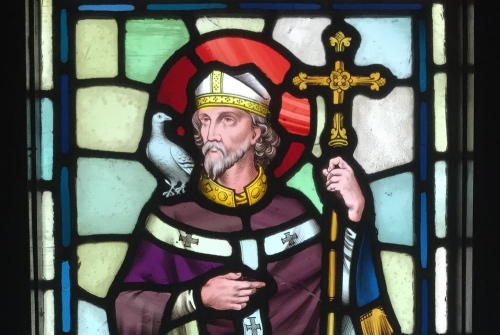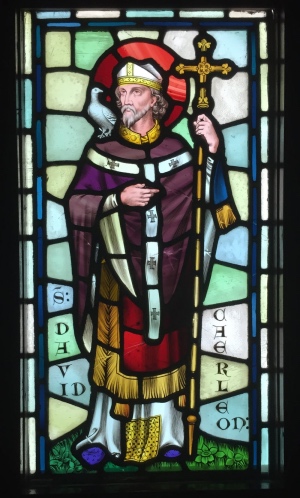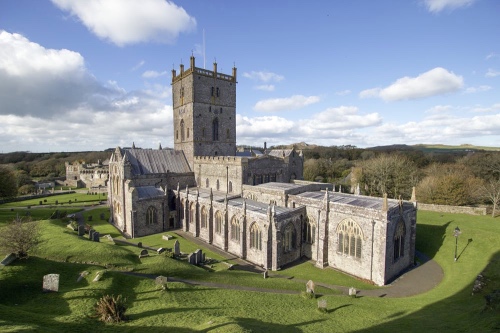
UK academic KATHRYN HURLOCK reflects on how it was the Welsh who had left their homeland who kept St David’s Day – marked on 1st March – alive…
On 1st March, St David is commemorated in Wales for his role as patron saint of the country and its people. From Abertawe to Ynys Mon, the Welsh use the day as one to celebrate their culture and heritage. But there was a time when St David’s popularity waned in Wales, and it was only thanks to the Welsh who had left the land of their fathers that St David’s Day was revived.
St David’s role as leader of the Welsh was established in the 10th century when the Welsh (together with the Scots, Irish and Cornish) were urged to fight against Athelstan of England under the spiritual protection of David. The poem asking them to fight, Armes Prydein Vawr (the Great Prophecy of Britain), called St David their leader whose prayers would help defeat the English.

St David, depicted in stained glass at Castell Coch, Cardiff. PICTURE: Hchc2009/Wikimedia
His fame was reinforced in the 1120s when Pope Calixtus II declared that English pilgrims who went to St David’s Cathedral in Pembrokeshire twice would have the same spiritual reward as if they went to Rome once. This honour was not extended to any other place in Britain.
The cathedral became Wales’ premiere pilgrimage site, visited by English kings like Henry II and Edward. Meanwhile St David’s day on 1st March became the most important date in the Welsh calendar of worship. It was so universal that when men from Wales settled in Ireland after its conquest in 1169, they still used St David’s day to date documents.
Henry VII, first of the Tudor kings of England, also revered St David. Born in Wales but largely brought up in exile in Brittany and France, when Henry returned to take the crown from Richard III in 1485, he called on the Welsh to go with him in the name of God and of St David. Once he was king, Henry celebrated St David’s day with the royal court each year.
However, during the 16th-century Reformation, St David, his cult, and his cathedral came under attack from reformers. When Englishman William Barlow was appointed bishop of St David’s in 1536, he stripped the cathedral of its relics and tried to get the office of bishop moved around 45 miles east to Carmarthen. He also wrote to Thomas Cromwell, outraged that the Welsh thought David good enough to be a patron saint.
“By the 18th century, St David was again being celebrated as the patron saint of Wales, but only really thanks to the Welsh who had left the land.”
Welsh diaspora
There is little evidence that St David was enthusiastically worshipped as a patron saint in Wales in the following two centuries. His memory was kept alive, however, in England, though in a much altered form, that was far removed from his earlier image as a holy man.
In the late 1590s, a book, written by Londoner Richard Johnson, described David as patron of Wales, but showed him as a man who (along with the other patron saints in the book) went on fantastical adventures, killing monsters and rescuing ladies.
By the 18th century, St David was again being celebrated as the patron saint of Wales, but only really thanks to the Welsh who had left the land. Interest began in 1704 in Dublin, with the publication of a work praising the saint, and was followed in London where the “Honourable and Loyal Society of the Antient Britons” celebrated with a sermon on St David’s Day. So too did the Welsh of Philadelphia, where the Welsh society was founded in 1729.
Though many of these celebrations involved singing and sermons, not all did. When the Antient Britons developed into the Honourable Society of the Cymmrodorion in 1751, they held their regular meetings in taverns. Such meetings must have been popular, as by 1762, St David was the only patron saint in Britain whose day was a public holiday.
This formal recognition, coupled with the elevation of saints of England, helped St David find popularity once again in Wales. In the 19th century, St David’s Day was celebrated with sermons and dinners in Wales. A number of educational establishments were dedicated to him, including St David’s College, Wales’ first university, founded in 1828 by Bishop Burgess of St David’s.

St David’s Cathedral, Pembrokeshire. PICTURE: jax10289/Shutterstock
In 1923, the story of St David’s medieval life was translated from Latin and published in English for the first time, and Welsh poets like Saunders Lewis took an interest in St David as Welsh patron. Lewis portrayed David as a man who aided miners in the coalmines of Wales. He was also the subject of modern sculpture, and considerable effort was put into restoring the cathedral of St David’s. When the Church of Wales produced its first hymnbook in 1941, no fewer than five of the hymns were to David.
![]() Today, thanks in part to the early survival of St David’s Day celebrations outside Wales, St David’s day is once again celebrated widely in his homeland. It is also enjoying something of a resurgence overseas. Since 2011, Los Angeles has hosted a St David’s Day festival, and Welsh communities from Patagonia to Denver fittingly celebrate St David as patron saint with song.
Today, thanks in part to the early survival of St David’s Day celebrations outside Wales, St David’s day is once again celebrated widely in his homeland. It is also enjoying something of a resurgence overseas. Since 2011, Los Angeles has hosted a St David’s Day festival, and Welsh communities from Patagonia to Denver fittingly celebrate St David as patron saint with song.
Kathryn Hurlock, is a senior lecturer in medieval history at Manchester Metropolitan University. This article was originally published on The Conversation. Read the original article.






